Long before the Progressive Conservative government unveiled its plans to revamp Ontario Place, Premier Doug Ford was presented with a list of 10 under-consideration companies that offered a world of opportunity for the redevelopment project.
Contenders highlighted in the government document given to Ford a couple of weeks before the submission deadline featured mostly Canada-based companies, including the upstart entertainment business started by a former World Wrestling Entertainment (WWE) executive and a pair of spa-builder alternatives to Therme Group.
Other companies included posed the possibility of similar visions Premier Doug Ford previously had for another piece of Toronto’s waterfront, including a mega mall and ferris wheel.
EcoRecreo, which later backed out, and Therme were also early contenders for the redevelopment of the largely provincially owned site, documents obtained through Ontario’s freedom of information system show.
On Sept. 11, 2019, between the Ford government’s original and extended deadlines for Ontario Place redevelopment proposals, the premier was given a status update on the process by the cabinet minister he’d put in charge of it, Lisa MacLeod.
The slide deck MacLeod, then-Ontario’s tourism, culture and sport minister, used to brief Ford included 10 “select team profiles” of companies for the redevelopment. They were: Therme Group, Merlin Entertainments, Triple Five Group, EcoRecreo, Pomeroy Lodging, a Kilmer Group company, Lemay, Badenhaus Spa, Global RE, and Camillion Corp.
Live Nation was not included but was already a presumed redevelopment partner. Its lease of Budweiser Stage, the 16,000-person-capacity amphitheatre at Ontario Place, lasts until 2030. Live Nation plans to transform it into a year-round concert venue.
The provincial government has mostly kept a lid on information about which other companies were in the running to transform Ontario Place. Bidders signed non-disclosure agreements as well.
A spokesperson for Infrastructure Minister Kinga Surma said in a statement this week that the Sept. 11, 2019 slide deck was “presented for informational purposes only and to provide a briefing of known interest in the Call for Development at that time.”
Surma has been the point person within Ford’s cabinet on the Ontario Place redevelopment over the last year-plus.
“These slides do not represent any ranking or evaluation whatsoever, as the Call for Development process was still ongoing and did not close until Sept. 24, 2019, and submissions were continuing to be received,” Andrea Chiappetta, Surma’s press secretary, wrote in the statement sent by email on Wednesday.
Therme’s and EcoRecreo’s proposals were chosen from 34 total submissions, according to a briefing document given to current Tourism, Culture and Sport Minister Neil Lumsden in the summer of 2022, which The Trillium reported in May of this year.
The government announced Therme, EcoRecreo and Live Nation would be involved in the project on July 31, 2021. EcoRecreo and the government’s plans fell through a year later after they couldn’t agree to terms on a long-term lease.
Merlin Entertainments, one of the other companies listed in the Sept. 11, 2019 presentation to Ford that wasn’t included in the site’s overhaul, operates more than 130 tourist attractions and theme parks in more than two-dozen countries.
Merlin runs attractions like the London Eye ferris wheel in the U.K. where the company is headquartered, plus LEGOLAND locations around the world, including its lone Canadian attraction in Vaughan.
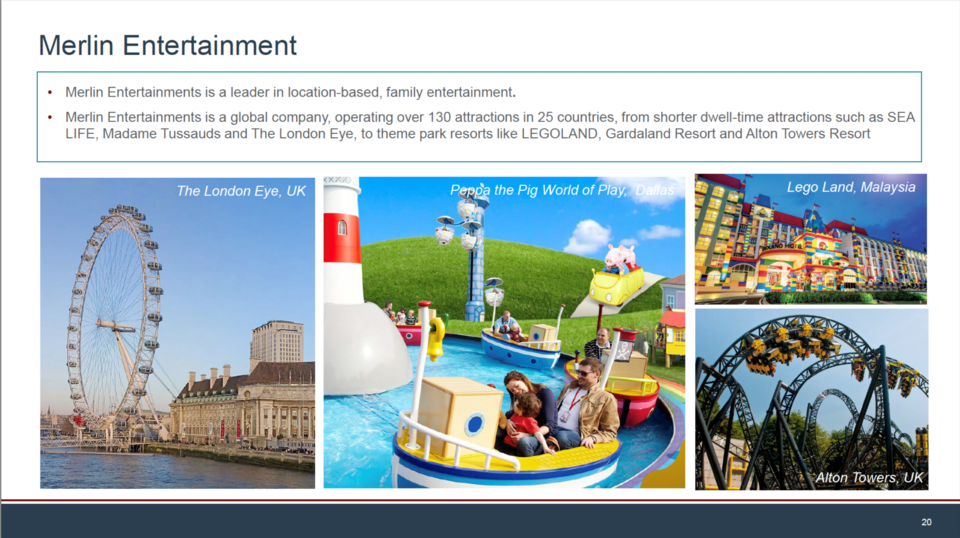
Merlin isn’t a builder itself and didn’t submit a formal proposal to redevelop Ontario Place to the government, according to one source close to the situation. Its website says its “preferred structure” is “as a tenant, supported by a development contribution from a landlord.”
Triple Five Group, based in Alberta, is the company behind the West Edmonton Mall. It, the Mall of America in Minnesota, and the American Dream mall in New Jersey near its border with New York, were all built by Triple Five. They were described as “the world’s first, second and third largest tourism, retail and entertainment complexes” in the Sept. 11, 2019 presentation made to Ford.
Economic Development, Job Creation and Trade Minister Vic Fedeli and the head of an investment brokerage had tried arranging a meeting about Triple Five about a month before the presentation, emails between them show. Neither Fedeli’s office, nor the brokerage executive got back to The Trillium about whether this meeting materialized or not before this story was published.
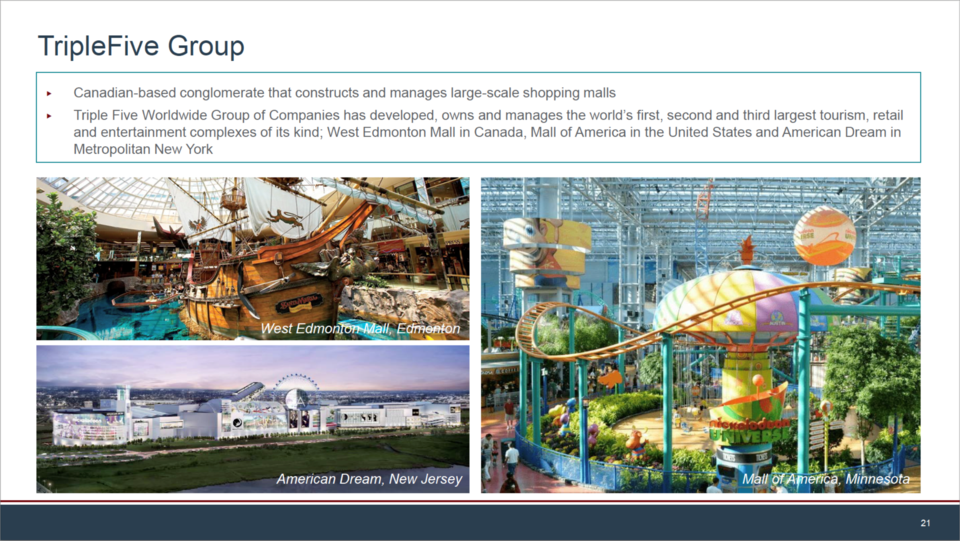
A waterfront ferris wheel and mega mall were components of the vision Ford once laid out for another part of Toronto’s waterfront in one of the most memorable moments from his term on city council.
On Aug. 30, 2011, during the first year that Ford was a councillor and his brother Rob was mayor, the premier boasted on CBC Metro Morning about a forthcoming redevelopment proposal for Toronto’s port lands, located about five kilometres east of Ontario Place on the waterfront.
The plans Ford pumped as “spectacular, just spectacular” also included a monorail and boat-accessible-hotels. They were never realized.
Including Therme, three of the 10 “select team profiles” highlighted in the Sept. 11, 2019 presentation were spa builders. The other two were Canadian companies: Pomeroy Lodging and Badenhaus Spa.
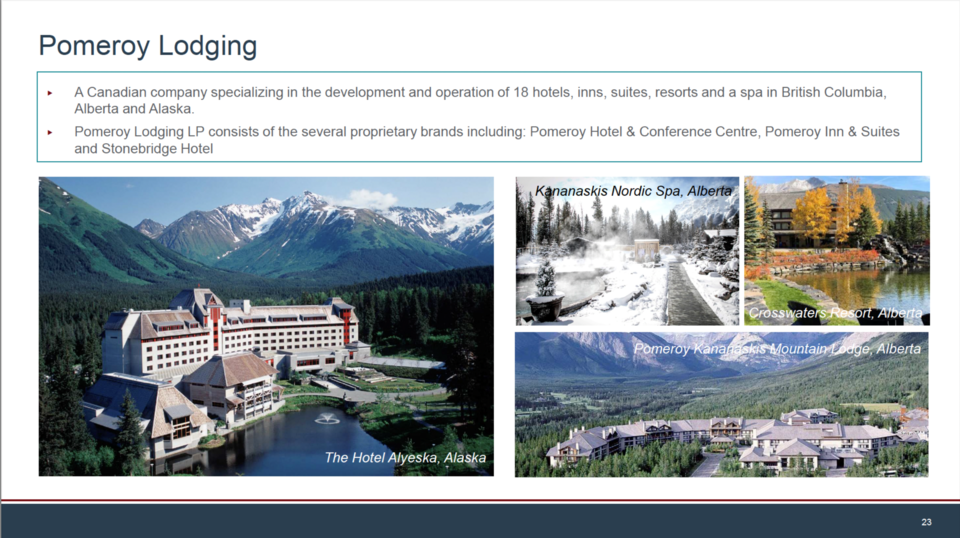
Pomeroy Lodging includes several different hotel and resort brands, along with the Kananaskis Nordic Spa in Alberta, which it opened in 2018 after buying and renovating a pre-existing facility.
Corporate records of Pickering-based Badenhaus shows it was incorporated in the province in the middle of the four-month-long call for development the government held in 2019. “Their designs focus on water therapy, open space and light,” the slide dedicated to it in the presentation to Ford noted, along with that it had “no facilities currently in operation.”
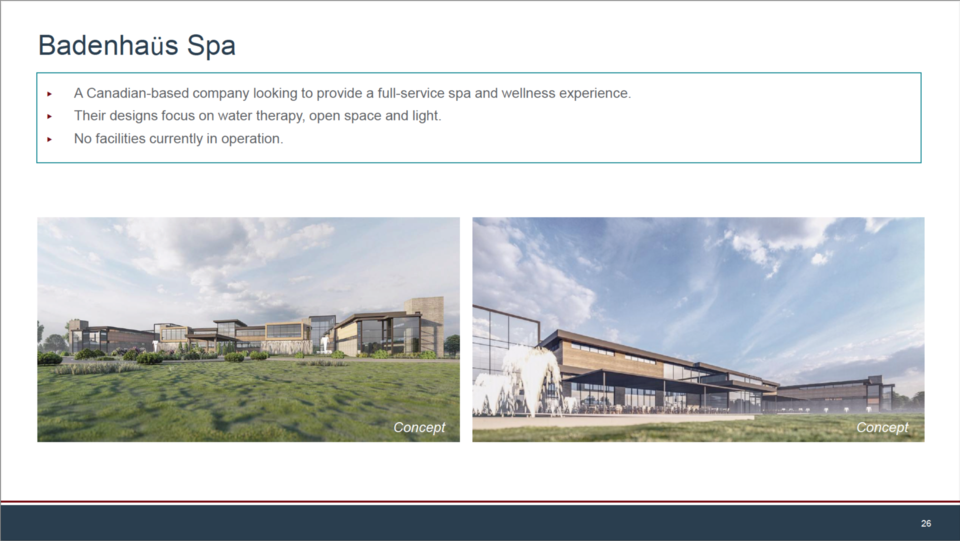
Lemay, a Montreal-based design firm, was described as an “internationally recognized integrated design firm” that “design(s) exceptional living environments that deliver concrete and measurable benefits for clients, users and the community.” Lemay has designed projects in Canada, Asia, Latin America and the Caribbean, which has included parks and other public spaces, offices, hospitals, transit stations, and more.
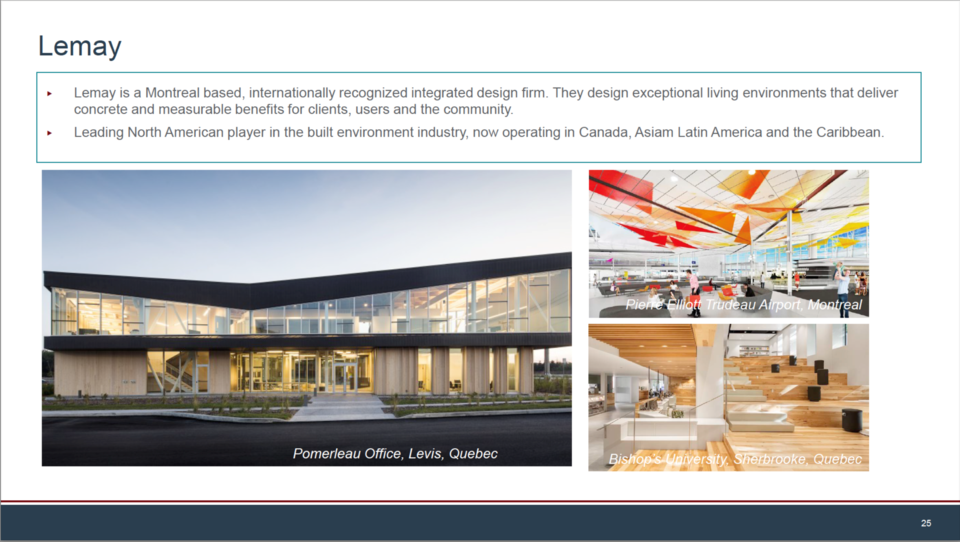
The slide in the Sept. 11, 2019 presentation dedicated to Global RE Group contains the least information of all the companies listed. Unlike all but one other option (Camillion) shown, Global RE’s slide included no photos nor conceptual images. The single bullet point explaining the company says it’s a “privately-owned real estate investment company that is primarily focused on the acquisition and development of innovative commercial, hotel, and residential assets in select markets across the globe.”
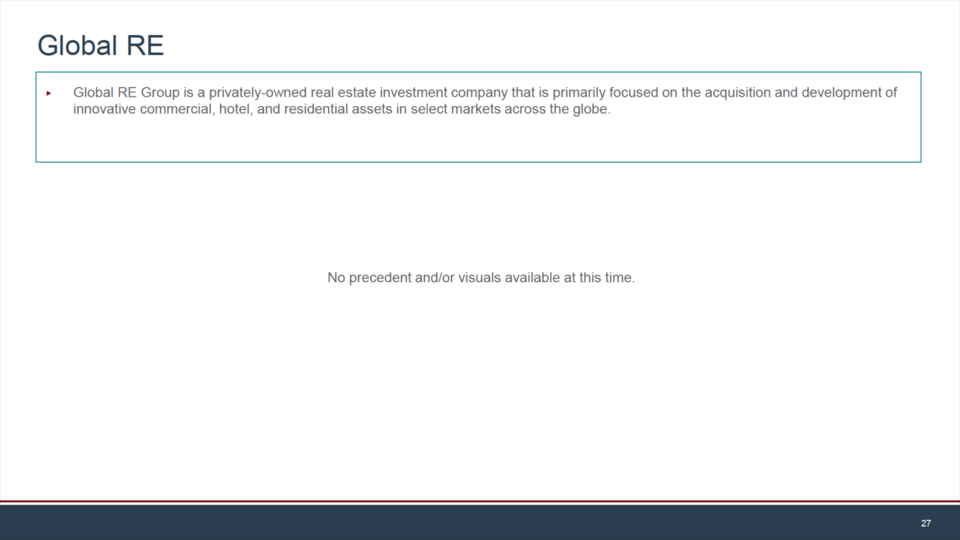
The Kilmer Group company’s and Camillion’s interest in the redevelopment has been previously reported on.
Kilmer Van Nostrand Co. Limited is part of the Tanenbaum family’s corporate empire.
In a March 2019 presentation, which is now online, Kilmer proposed rearranging the city’s and province’s management of Ontario Place and Exhibition Place, the adjacent mainland entertainment area, so that they split responsibility for roughly half of each, adding underground parking at Exhibition Place, upgrading many of the existing facilities on both sites, and relocating the province’s Science Centre there.
Speaking to the Globe and Mail in July 2020, Ken Tanenbaum, vice-president of Kilmer Group, expressed that he felt the area could become a “Union Station West,” with the planned Ontario Line subway intersecting with Exhibition Place’s GO Transit station. “A variety of smaller uses makes sense” in this context, Tanenbaum said.
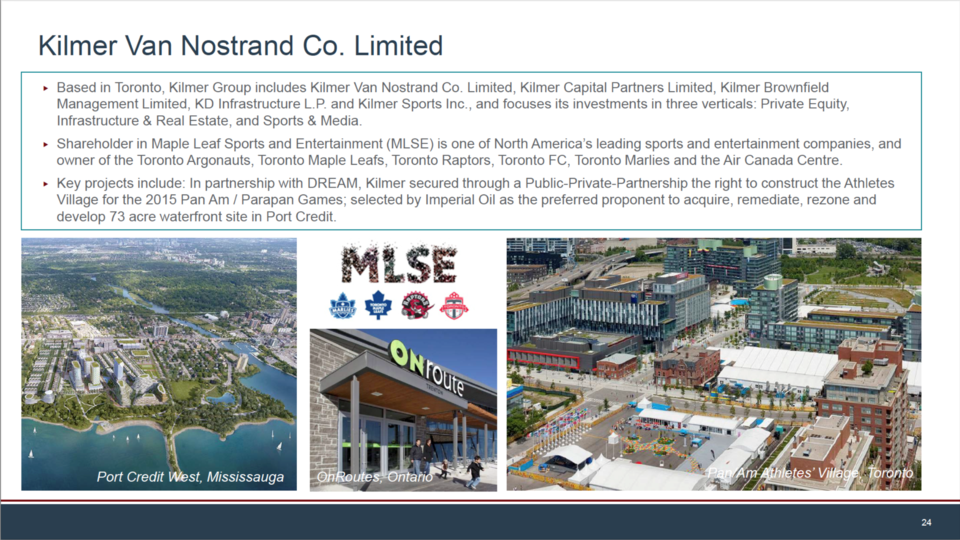
Camillion envisioned a “world-class, iconic development” to attract international tourism, a lawyer for the company told the Globe and Mail while the bid-submission process for Ontario Place was open in 2019. Although its CEO Carl Demarco had previously been the president of global business development and longtime head of Canadian operations for the WWE, the company’s lawyer suggested its bid would not involve professional wrestling.
The Sept. 11, 2019 slide deck described Camillion as “a media company with interests in the technology/innovation sector” and emphasized Demarco’s success in the pro-wrestling business.
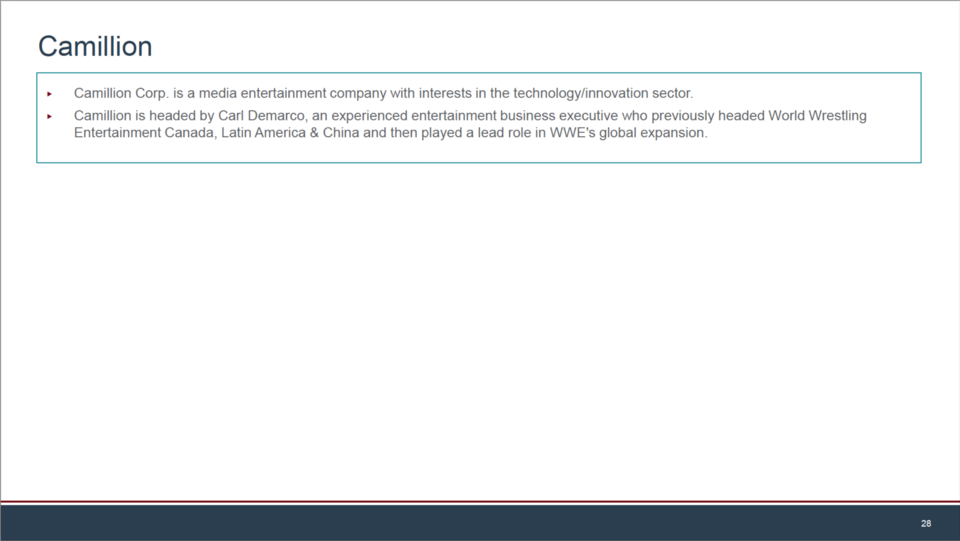
In May 2020, early in the pandemic, Camillion hired a lobbyist to try to get the Ontario government to buy a COVID-19 screening and testing device called the “Citizen Care Pod,” which its lobbying registration says it designed.
A 2020 promotional video for the Citizen Care Pod shows it to essentially be a repurposed shipping container that health-care workers could run mini-COVID-19-testing clinics out of.
Therme Group is described in the Sept. 11, 2019 presentation as being “in the process of rolling out a 10-year global presence strategy with selected projects under development in North America, Europe, and Asia.” The slide dedicated to the builder of spas, recreational and wellness facilities says its “complexes attract up to 6M visitors/year.”
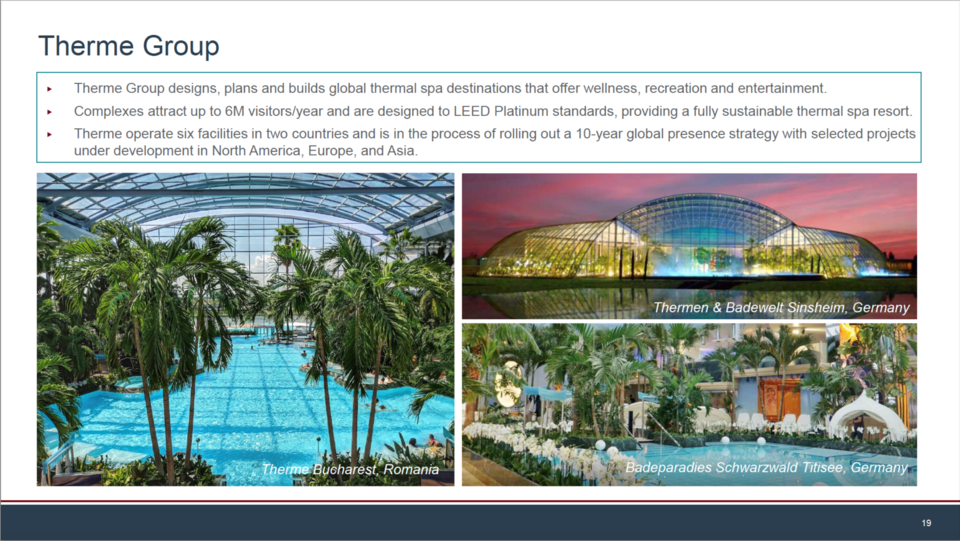
EcoRecreo’s Canadian-based operations were noted in its slide, as were photos of a few of their tourist attractions in Quebec.
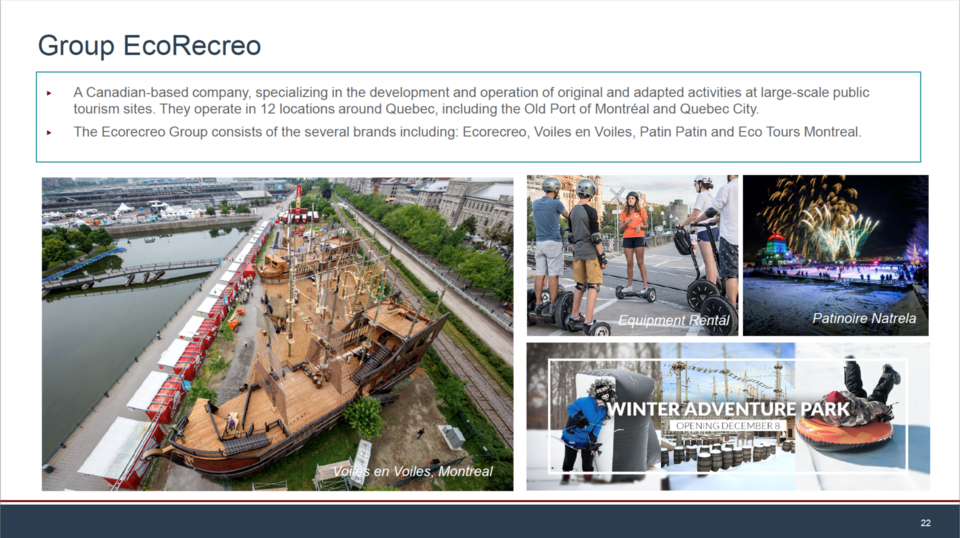
Other slides from the Sept. 11, 2019 Ontario status update presentation on the parameters of the redevelopment project and how submissions would be assessed closely reflected what had been published in the call for development three months earlier.
Another slide includes information about the work KPMG and Colliers did for the government to draw in submissions. It says the consulting companies sent “400+” emails to “industry contacts,” and made “300+” phone calls and emails to “high-potential parties.” They also advertised in major international print publications including the Wall Street Journal, Financial Times and South China Post, the slide deck says.


